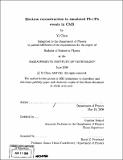Electron reconstruction in simulated Pb+Pb events in CMS
Author(s)
Chen, Yi, S.B. Massachusetts Institute of Technology
DownloadFull printable version (2.114Mb)
Other Contributors
Massachusetts Institute of Technology. Dept. of Physics.
Advisor
Gunther Roland.
Terms of use
Metadata
Show full item recordAbstract
Introduction: The Large Hadron Collider (LHC) located at Geneva, Switzerland, will be the biggest particle accelerator in the world. There are a number of detectors on the LHC ring. The LHCb detector is aimed to study bottom quark physics, which will allow a measurement of the parameters of CP violation in bottom quark productions. The ALICE experiment is specialized in Pb+Pb heavy ion collisions. The ATLAS [3] detector is a general purpose detector, and it will be conducting p+p collision experiments. In addition, the Compact Muon Solenoid (CMS) is currently being commissioned. It will start taking data from as early as late 2008. The detector will be excel in muon detection, but it is also a general purpose detector for p+p and Pb+Pb collsions. The CMS experiment opens up a new window into physics at a unprecedented energy. With the new energy range, a lot of exciting new physics can be examined. The search for the HIGGS boson, which arises from scalar field and is postulated to account for the mass of vector bosons, is one of the main goals of the experiment. The energy range of the LHC is well matched for either confirming its existence or ruling it out. The LHC experiments also want to research on super-symmetry, which potentially explains a lot of open questions for physics beyond the standard model. Although the CMS detector will devote most of its time running proton-proton collisions, one month of each year it will be running lead-lead collisions at center-of-mass energy of 5.5 TeV. Through heavy ion collisions more about the properties of the quark-gluon plasma can be studied, like the viscosity or opacity. In preparation for further studies to the lead-lead collisions, it is interesting to test the basic detector capabilities by studying basic particle reconstruction capabilities. Reconstruction of prompt photon in the heavy ion background has been studied by the MIT heavy ion group last summer, and it leads to the main goal of this thesis. Electrons are one of the main background of the photons, and certainly an important particle type that future studies might need. Inside the CMS detector there will be a roughly constant magnetic field 4.0 Tesla maintained by a superconducting magnet, which allows good measurement of the particle momentum. A slice of the detector is shown in Figure 1. The detector consists of several parts, from inside to outside there are silicon trackers, electromagnetic calorimeter (ECAL), hadronic calorimeter (HCAL), and finally the muon chambers. The tracker is specialized of measuring the momentum of charged particles. The particles will leave a trace on the tracker as they fly through the detector. One important feature about the readout of the tracker is that the output is not binary. Instead, it has an multiple-bit ADC value which allows for better measurement of the direction and better identification of the particle that passes through the tracker. This makes the tracker good for heavy ion events. The electromagnetic and hadronic calorimeters measure energies of different types of particles. Particles such as electrons and photons will deposit most of its energy into the electromagnetic calorimeters, whereas hadrons dump most of their energy into the hadronic calorimeter. The measurement of missing energy in hadronic calorimeter also provides signature of new particles. This study will be focused on the reconstruction of electrons in heavy ion back ground. The reconstructed electrons are then used to show that the reconstruction of the invariant mass of Z⁰ boson in heavy ion background is possible. The expected number for various particles is listed in section 2. In section 3 the simulated samples used for the study. In the following two sections the reconstruction procedure and the reconstruction properties for electrons. In section 6 the background sources to electrons and the reconstruction of Zo are discussed. Last but not least, additional cuts used for Z⁰ reconstruction and the results are written in section 7.
Description
Thesis (S.B.)--Massachusetts Institute of Technology, Dept. of Physics, 2008. Includes bibliographical references (p. 34).
Date issued
2008Department
Massachusetts Institute of Technology. Department of PhysicsPublisher
Massachusetts Institute of Technology
Keywords
Physics.